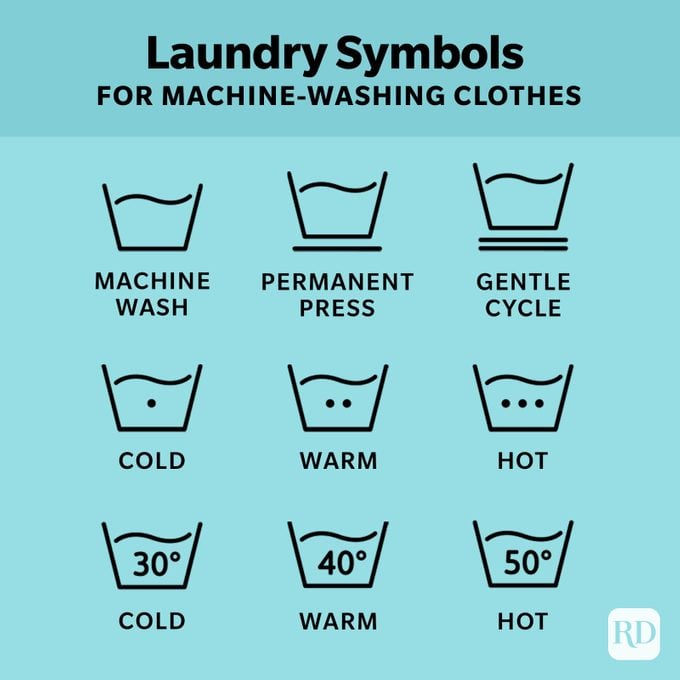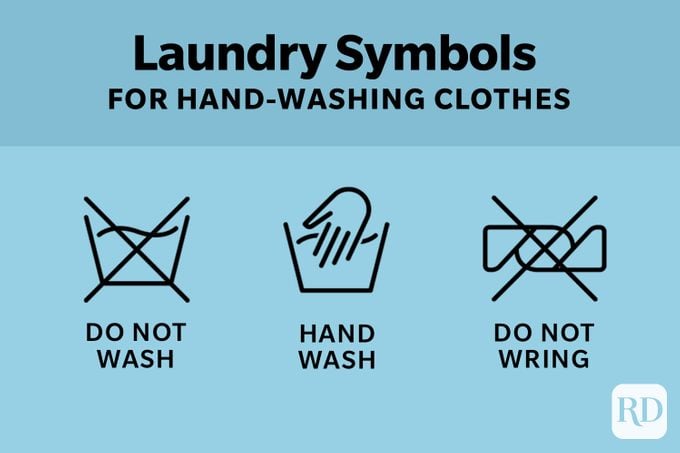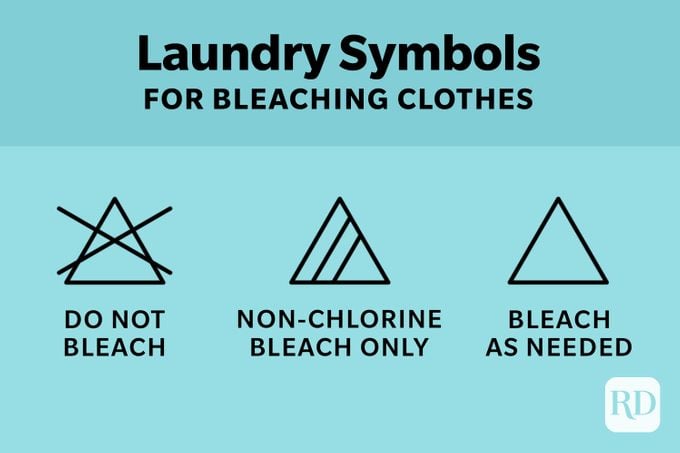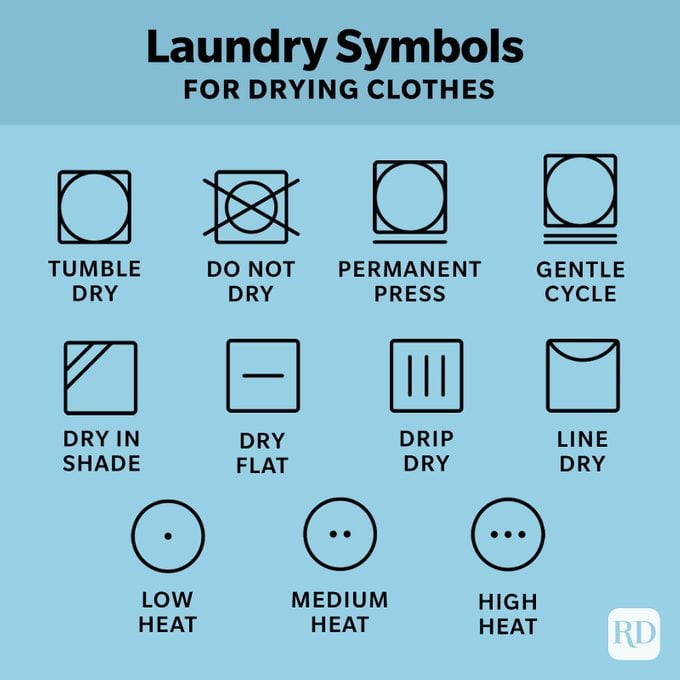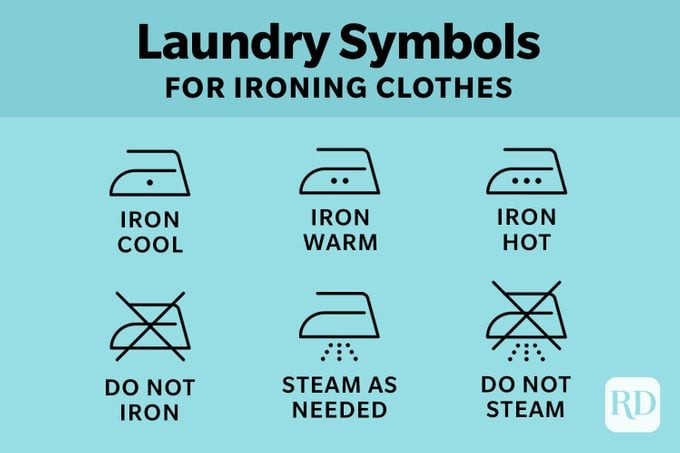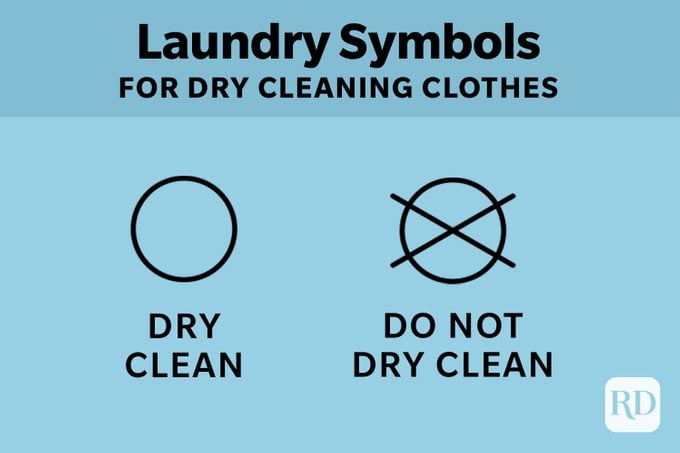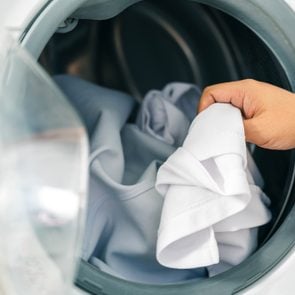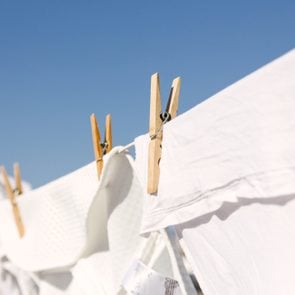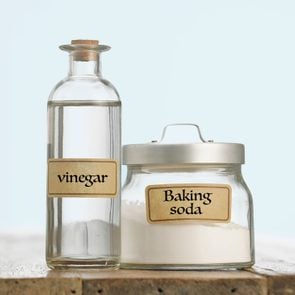A Guide to Laundry Symbols: Find Out What Those Washing Symbols Mean
Updated: Feb. 29, 2024
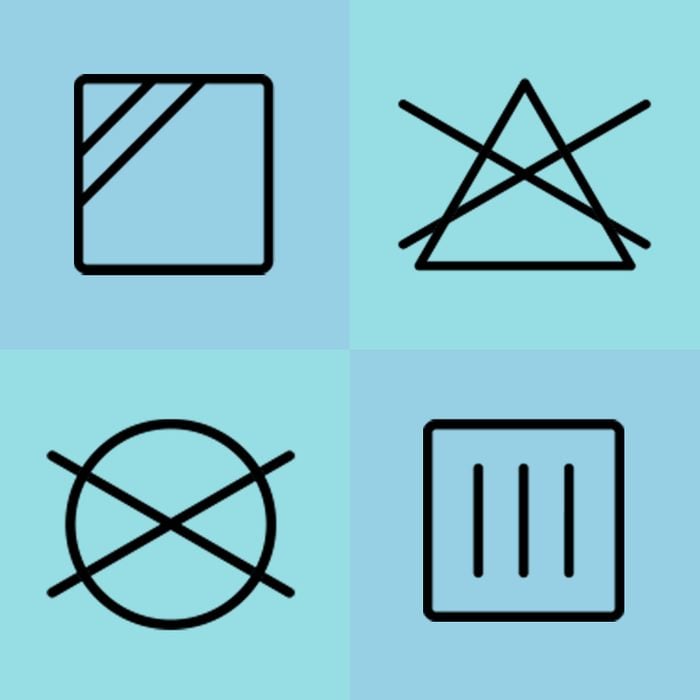
You know those hieroglyphic-like laundry symbols on clothing labels? They relay important cleaning information. Here's what they mean and how to use them.
A picture may be worth a thousand words, but sometimes it’s more confusing than text. That goes double when it’s one of the many laundry symbols found on the care label of your clothes. What are all those circles, squares, and triangles—and why should you care about them?
Clothing manufacturers use washing symbols to help you extend the life of your clothes. Sure, you may think you know how to wash clothes, how to hand wash clothes, how to wash delicate fabrics like silk, how to use a washing machine, how to separate laundry, and how to put liquid fabric softener in the fabric softener dispenser. You might even use the best laundry detergent or know exactly how to use laundry pods the right way and take the time to set the washing machine temperature just right. But that doesn’t guarantee your clothing will stay in the same condition, color, or size.
“You risk destroying your clothes by not following the laundry care instructions,” says Alicia Sokolowski, president and co-CEO of Aspen Clean. “What might happen if you put a dry-clean-only garment in a washing machine? The garment could shrink—not just a little, but significantly. Garments made of wool can shrink two to three sizes or more, and drapes can shrink to half their size.” Instead of making it a guessing game—no, that’s not an envelope, suggesting you send the item to your mom to clean; it’s the sign for “hang to dry”—we asked the experts to decipher the most common washing instruction symbols. Here’s your comprehensive laundry symbols guide, complete with laundry symbols charts. Bonus: For perfectly folded laundry, also check out this shirt folding board.
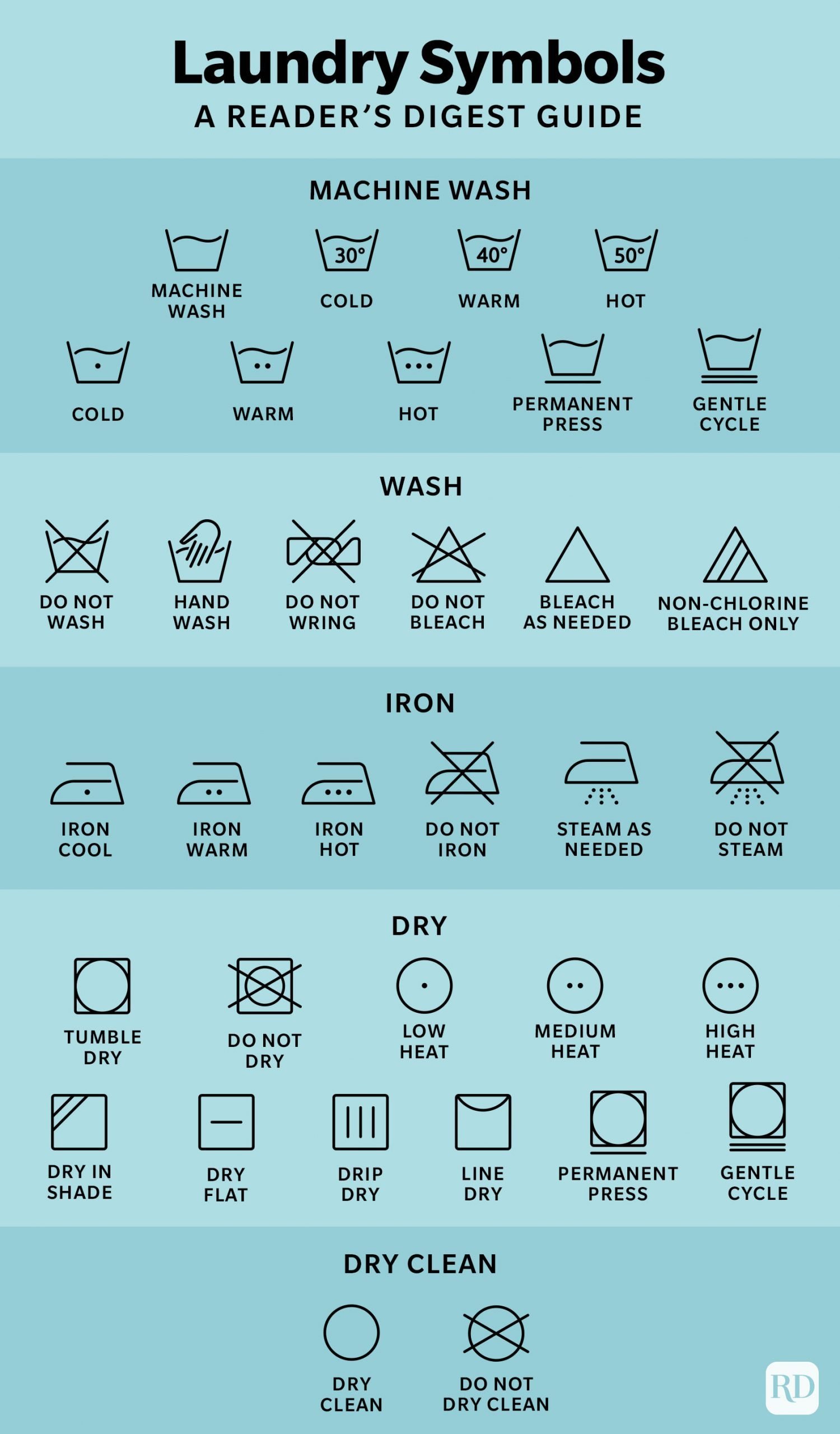
What are international laundry care symbols?
Because people do laundry all around the world, the industry has created a standard of five basic symbols that form a kind of universal language. To make it even easier, laundry symbols are always featured in the same order on a label. From left to right, they are:
- Washtub (washing)
- Triangle (bleaching)
- Iron (ironing)
- Circle (dry cleaning)
- Square (drying)
“As you go through the five basic international symbols, you’ll start to see a pattern,” said Annette Grant and Sarah Karakaian, full-time short-term rental managers and hosts of the “Thanks for Visiting” podcast. “It’s like its own language where, for example, two lines under an icon or three dots inside an icon always mean the same thing. Once you learn these, you’ll be fluent in care tags in no time.”
According to fashion stylist Leena Alsulaiman, one of the most important symbols to pay attention to is a large X. “When a symbol is crossed out,” she warns, “that’s your sign not to do that thing.”
Laundry symbols for how to machine wash clothes
The washtub symbol indicates instructions for every step of the washing process, whether you’re using a traditional or HE washer. If the garment is machine washable, you’ll see either dots or numbers inside it, representing the recommended maximum water temperature.
- Washtub with numbers: Because the temperature is shown in degrees Celsius, the number 30 indicates a cold-water wash, 40 indicates a warm-water wash, and 50 indicates a hot-water wash.
- Washtub with dots: Dots inside the washtub indicate the same thing as a number: the water temperature. The more dots there are (there can be up to six of them), the hotter the temperature. So if you see a single dot, wash your garment in cold water. If you see three dots, though, wash the item in hot water.
Lines under the washtub signify that the garment needs to be washed on a special cycle.
- No lines: Normal wash cycle
- One line: Permanent press cycle
- Two lines: Gentle cycle
“Just remember, the more lines under the washtub, the more careful you should be,” says Alsulaiman. And finally, if your washtub has an X through it, back away from the washing machine. This means “do not wash.”
Laundry symbols for how to hand-wash clothes
If you see a hand reaching into the washtub, that means your garment should be hand-washed only. Do not put it in the washing machine. There’s another washing symbol that indicates how to hand-wash clothes: If you see an icon that looks like a wrapped, hard candy with an X through it, don’t wring or twist the garment. Gently squeeze the water out after hand-washing it.
Laundry symbols for how to bleach clothes
The triangle tells you everything you need to know about bleaching an item. Here’s how to decipher the symbols:
- Empty triangle: You can use any type of bleach
- Triangle with two lines through it: You can use non-chlorine (or oxygen) bleach only
- Triangle with an X: No bleach should be used at all
Laundry symbols for how to dry clothes
Everything you need to know about how to dry an item can be found in the square on the care label. Be sure to check this before tossing your clothing in the wash to avoid shrinkage—unless, of course, you’re trying to shrink clothes. First, look for a circle in the square, which tells you it’s okay to dry the item in the dryer. If your square has both a circle in its center and an X through it, do not put the item in the dryer.
Just like with the washtub, the number of dots signifies the maximum temperature to be used:
- One dot: Cold
- Two dots: Warm
- Three dots: Hot
You may also notice lines beneath the square. As with the washtub icon, these indicate the proper dryer settings to use.
- One line: Permanent press cycle
- Two lines: Gentle cycle
All of that explains how to machine dry an item (and if you should). But if your square doesn’t have a circle at all, it should air-dry. Here’s how to interpret the various air-dry laundry symbols:
- One horizontal line: Lay it flat to dry.
- Three vertical lines: Hang it to drip dry.
- A square that looks like an envelope: Line dry it.
- Two diagonal lines: Dry it in the shade only.
Laundry symbols for how to iron clothes
With the abundance of wrinkle-free garments options, you might not spend much time wondering how to get wrinkles out of clothes. But there comes a time when your clothes really need to be ironed. The iron is the most self-explanatory of all the clothes-washing symbols. Once again, the number of dots signifies the maximum temperature that can be used.
- One dot: Cool
- Two dots: Warm
- Three dots: Hot
And, of course, an X means don’t iron it at all. When it comes to wrinkles, the steamer vs. iron debate comes down to fabric—and therefore the laundry symbols you see on your clothing tag. The following symbols relate to whether or not you should use steam on a garment. (P.S.—here’s how to clean an iron so your clothes don’t get damaged.)
- Three little bursts of steam under the iron symbol: It’s safe to steam the garment.
- An X over an iron with three bursts of steam: Avoid steaming.
Laundry symbols for dry cleaning clothes
You can try your hand at dry cleaning at home, but chances are you’ll want to leave it to the pros, so pay attention to the clothing label. The symbol for dry cleaning is a circle, and if it doesn’t have an X through it, it means you can take it to the dry cleaner. If the label specifies “dry clean only,” you should definitely take it to the dry cleaner. An item with this label is one of the things that should never end up in your washing machine.
Sometimes there are letters inside the circle, but don’t worry about those. They indicate the kinds of chemicals that can be used on a garment and are meant for professionals. Your dry cleaner will understand.
Sources:
- Leena Alsulaiman, fashion stylist, style consultant and coach
- Annette Grant and Sarah Karakaian, professional short-term rental managers and hosts of the “Thanks for Visiting” podcast
- Alicia Sokolowski, president and co-CEO of Aspen Clean
Related: Learn how to remove fabric pilling and prevent those annoying balls from forming.

